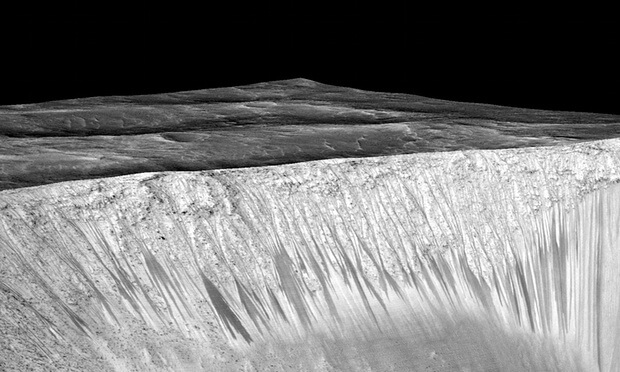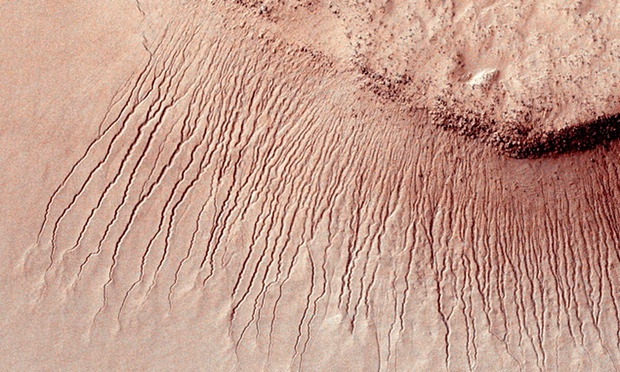Researchers say finding of stains from spring streams down cliffs and crater walls raises the chance of discovering life on red planet.
Liquid water keeps running down gullies and crater walls over the summer months on Mars, as per the researchers who say the finding increases the chances of being home to some type of life.
The streams leave long, dim stains on the Martian territory that can achieve many meters downhill in the hotter months, before they go away in the fall as surface temperatures drop.
Pictures taken from the Mars orbit show precipices, and the lofty walls of valleys and craters, streaked with summertime flows that in the most active spots come together to form complicated fan-like patterns.
Researchers are uncertain where the water originates from, however it may ascend from underground ice or salty aquifers, or consolidate out of the dainty Martian environment.
“There is fluid water today on the surface of Mars,” Michael Meyer, the lead researcher on Nasa’s Mars exploration programme, told the Guardian. “On account of this, we think that it is in any event conceivable to have an inhabitable environment today.”
The water streams could point Nasa and other space agencies towards the most encouraging destinations to discover life on Mars, and to landing spots for future human missions where water can be gathered from a natural supply.
“Mars is not the dry, parched planet that we considered previously,” said Nasa’s Jim Green. “Fluid water has been found on Mars.”
A few of the initial missions to Mars uncovered a planet with a watery past. Pictures channeled back to Earth in the 1970s demonstrated a surface crossed dried-up streams and fields once submerged underneath limitless antiquated lakes. Recently, Nasa revealed evidence of an ocean that may have secured half of the planet’s northern hemisphere in the distant past.

But intermittently, Mars tests have discovered clues that the planet may in any case be wet. Nearly a decade ago, Nasa’s Mars Global Surveyor took pictures of what emerged to be water bursting through a gully wall and streaming around rocks and other rocky debris. In 2011, the high-resolution camera on Nasa’s Mars Reconnaissance Orbiter captured what looked like little streams flowing down crater walls from late spring to early autumn. Not having any desire to expect excessively, mission researchers named the streams “repeating slant lineae” or RSL.
Researchers have now twisted to another instrument on board the Mars Reconnaissance Orbiter to evaluate the science of the secretive RSL streams. Lujendra Ojha, of Georgia Institute of Technology in Atlanta, and his colleagues used a spectrometer on the MRO to look at infrared light reflected off steep rocky walls when the dull streaks had quite recently started to show up, and when they had developed to full length toward the end of the Martian summer.
Writing in the journal Nature Geosciences, the team depicts how it discovered infra-red marks for hydrated salts when the dull streams were available, yet none before they had developed. The hydrated salts – a blend of chlorates and perchlorates – are a smoking gun for the occurrence of water at all four destinations examined: the Hale, Palikir and Horowitz craters, and a large canyon called Coprates Chasma.
“These may be the best places to scan for surviving life close to the surface of Mars,” said Alfred McEwen, a planetary geologist at the University of Arizona and senior creator on the study. “While it would be signifivant to discover confirmation of antiquated life, it is hard to comprehend the biology. Current life would be substantially more informative.”
The streams just show up when the surface of Mars ascends above – 23C. The water can keep running in such bone chilling conditions because the salts bring down the the freezing point of water, keeping it liquid far beneath 0C.
“The mystery has been what is allowing this stream? Apparently water, however up to this point, there has been no ghostly mark,” Meyer said. “From this, we presume that the RSL are produced by water associating with perchlorates, shaping a saline solution that streams downhill.”

John Bridges, a teacher of planetary science at the University of Leicester, said the study was interesting, yet may hurl some crisp attentiveness toward space organizations. The streams could be utilized to discover water sources on Mars, making them prime spots to chase forever, and to land future human missions. Be that as it may, agencies were required to do their most extreme to abstain from ruining different planets with organisms from Earth, making wet territories the most hard to visit. “This will give them lots to consider,” he said.
For the present, researchers are centered on taking in where the water originates from. Permeable rocks under the Martian surface may hold solidified water that melts in the late spring months and leaks up to the surface.
Another possibility is profoundly focused saline aquifers are specked around underneath the surface, not as pools of water, but rather as immersed volumes of lumpy rock. These could bring about streams in a few territories, however cannot easily clarify leaking down from the highest point of crater walls.
A third possibility, and one favored by McEwen, is that salts on the Martian surface assimilate water from the environment until they have enough to run downhill. The procedure, known as deliquescence, is found in the Atacama Desert, where the subsequent moist patches are the main known spot for organisms to live.
“It’s an intriguing bit of work,” Bridges said. “Our perspective of Mars is changing, and we’ll be examining this for quite a while to come”.
Also Read: What Will Happen When An Asteroid of 500 Km Hit The Earth & Will Earth Experience 15 Days Of whole Darkness In the month of November 2015?




























